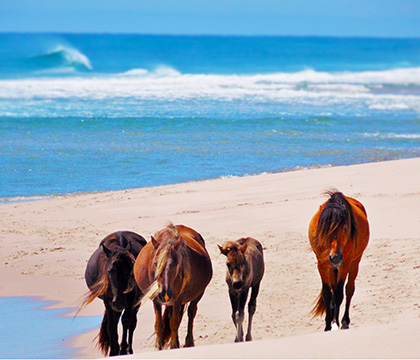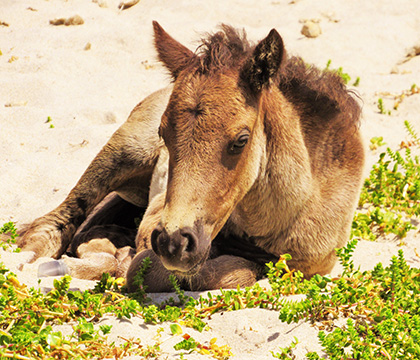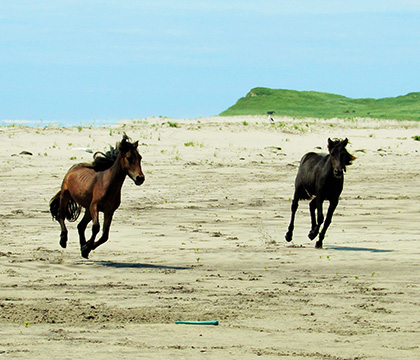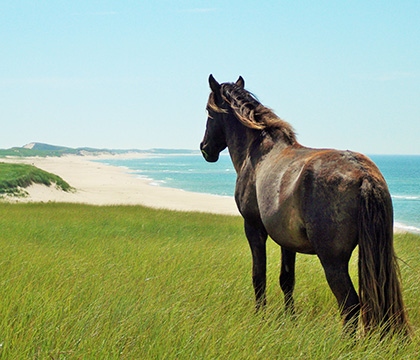
Feral horses focus of Sable Island study
My feet and back are aching, my boots are filled with sand, and I have horse manure all over my hands after a day of collecting fecal samples.
By Amber Backwell
I've just finished a 15-kilometre hike, an almost daily occurrence, and I'm heading back to the research station to help with another four or five hours of lab work. I'm utterly exhausted, and I know that I will have to wake up tomorrow at 7:30 a.m. to do it all over again.
Despite the pain and fatigue, I wouldn't trade places with anyone. Who else gets to spend weeks on a beautiful island in the Atlantic Ocean, surrounded by the iconic Sable Island horses that many others only dream of encountering?
This is the life of a Sable Island researcher – a summer experience that I will be eternally grateful for.
Horses began arriving on Sable Island as early as the 1700s when it was used as a holding place for the sale and shipment of horses to various destinations. The island and its inhabitants are now under the management of Parks Canada and although grey seals and a variety of bird species live on the island, no species has drawn more national attention than Sable Island's resident horses.
There are roughly 500 wild, or feral, horses that live on Sable Island. They're unique from domestic horses in that they have never received veterinary care such as regular vaccinations and deworming. They ingest large amounts of sand in their diets that would normally cause major health problems in domestic horses, and they have variable access to high quality food and water sources.

Ecologist Phil McLoughlin and his team of researchers from the University of Saskatchewan (U of S) have come to the island since 2007 to conduct research on the horses. His team collects a variety of information on the horses such as life history, sickness and death rates, social groupings, health status and genetics.
In particular they're collecting data on the gastrointestinal health of the horses, collecting yearly fecal samples from every horse to determine the presence of different parasites and bacteria. This information will help researchers better understand food assimilation, gut fauna and antimicrobial resistance patterns in a population of horses as close to their ancestral condition as it gets.
Sable Island is the perfect set up for a study on population density and ecology. Researchers can easily identify the horses without capture. They can track the animals over long periods of time and easily find them again and again because of the lack of trees on the island (there's only one). Plus the horses live without any competing species or predators, and they can't leave the island.
"It's neat because you can decompose population dynamics into contributions from every single individual," says McLoughlin.

What's intriguing is that the knowledge gained from the Sable Island horses and their population dynamics can be applied to other isolated wildlife populations throughout the world, potentially helping with conservation efforts.
For instance, the Sable Island horses' social structure can be compared to that of the mountain gorillas of Virunga in central Africa. Imagine if the lessons learned here could go toward benefiting other feral and endangered species — or to better understanding diet and deworming in domestic horses.
One focus of my research project is to analyze larvae grown from parasite eggs in the horses' fecal samples. I find high numbers of small and large strongyles, including a higher abundance of one parasite species (Strongylus equinus) compared to domestic horses. It's possible that this reflects a "founder" effect where only certain parasite species became shipwrecked along with their equine hosts on Sable Island, or perhaps this species does better than other parasites in the harsh conditions on the island.
These results will assist in verifying a genetic test that scientists can use to reliably differentiate among parasite species found in both domesticated and wild horses, which will have implications for diagnostic and treatment recommendations
Other parasitology results show that the feral horses' fecal egg counts (FECs) are higher than in most other horse populations. In particular, we find higher FECs in samples from mares with nursing foals and horses in poor body condition.
These findings suggest that gastrointestinal parasites may be one of the limiting factors for the horses' health and reproduction. But before we swoop in with dewormers, a combination of poor nutrition and parasites might be key to maintaining the herd's population at a sustainable size, given the island's small size and the harsh environment.
In addition to being a perfect model for population ecology studies, the Sable Island horses are of great cultural importance to the people of Nova Scotia and Canada. Although there is concern over the horses' welfare, particularly during rough winters, they will continue to attract tourists to the island and spark public interest for many years to come.

As my time on Sable Island comes to an end, I wonder what will happen when our research team leaves for the year. Will all of the horses I've seen here live to next year? Will that beautiful mare I encountered have another foal? Who will be living where and with what band of horses in a year's time?
"It's like the horses here lead little soap opera lives, and you have to wait a full year before you can watch the next episode of your favourite show," says PhD student Sarah Medill, who has been coming here for four years.
I will certainly miss this place and its horses. But on the other hand, I am looking forward to a day spent in clean clothes on solid ground without even the slightest whiff of horse manure.
This research is financially supported by the WCVM Townsend Equine Health Research Fund, the L. David Dubé and Heather Ryan Veterinary Health and Research Fund and the Natural Sciences and Engineering Research Council of Canada (NSERC). Special thanks to members of the McLoughlin and Jenkins labs at the U of S, in particular to Phil McLoughlin, Brent Wagner, Jocelyn Poissant (University of Calgary), Sarah Medill and Emily Jenkins, my supervisor.
Amber Backwell of Vancouver, B.C., is a second-year veterinary student who was the Townsend Equine Health Research Fund's summer research student in 2015. Amber's story is part of a series of stories written by WCVM summer research students.
Despite the pain and fatigue, I wouldn't trade places with anyone. Who else gets to spend weeks on a beautiful island in the Atlantic Ocean, surrounded by the iconic Sable Island horses that many others only dream of encountering?
This is the life of a Sable Island researcher – a summer experience that I will be eternally grateful for.
Horses began arriving on Sable Island as early as the 1700s when it was used as a holding place for the sale and shipment of horses to various destinations. The island and its inhabitants are now under the management of Parks Canada and although grey seals and a variety of bird species live on the island, no species has drawn more national attention than Sable Island's resident horses.
There are roughly 500 wild, or feral, horses that live on Sable Island. They're unique from domestic horses in that they have never received veterinary care such as regular vaccinations and deworming. They ingest large amounts of sand in their diets that would normally cause major health problems in domestic horses, and they have variable access to high quality food and water sources.

Ecologist Phil McLoughlin and his team of researchers from the University of Saskatchewan (U of S) have come to the island since 2007 to conduct research on the horses. His team collects a variety of information on the horses such as life history, sickness and death rates, social groupings, health status and genetics.
In particular they're collecting data on the gastrointestinal health of the horses, collecting yearly fecal samples from every horse to determine the presence of different parasites and bacteria. This information will help researchers better understand food assimilation, gut fauna and antimicrobial resistance patterns in a population of horses as close to their ancestral condition as it gets.
Sable Island is the perfect set up for a study on population density and ecology. Researchers can easily identify the horses without capture. They can track the animals over long periods of time and easily find them again and again because of the lack of trees on the island (there's only one). Plus the horses live without any competing species or predators, and they can't leave the island.
"It's neat because you can decompose population dynamics into contributions from every single individual," says McLoughlin.

What's intriguing is that the knowledge gained from the Sable Island horses and their population dynamics can be applied to other isolated wildlife populations throughout the world, potentially helping with conservation efforts.
For instance, the Sable Island horses' social structure can be compared to that of the mountain gorillas of Virunga in central Africa. Imagine if the lessons learned here could go toward benefiting other feral and endangered species — or to better understanding diet and deworming in domestic horses.
One focus of my research project is to analyze larvae grown from parasite eggs in the horses' fecal samples. I find high numbers of small and large strongyles, including a higher abundance of one parasite species (Strongylus equinus) compared to domestic horses. It's possible that this reflects a "founder" effect where only certain parasite species became shipwrecked along with their equine hosts on Sable Island, or perhaps this species does better than other parasites in the harsh conditions on the island.
These results will assist in verifying a genetic test that scientists can use to reliably differentiate among parasite species found in both domesticated and wild horses, which will have implications for diagnostic and treatment recommendations
Other parasitology results show that the feral horses' fecal egg counts (FECs) are higher than in most other horse populations. In particular, we find higher FECs in samples from mares with nursing foals and horses in poor body condition.
These findings suggest that gastrointestinal parasites may be one of the limiting factors for the horses' health and reproduction. But before we swoop in with dewormers, a combination of poor nutrition and parasites might be key to maintaining the herd's population at a sustainable size, given the island's small size and the harsh environment.
In addition to being a perfect model for population ecology studies, the Sable Island horses are of great cultural importance to the people of Nova Scotia and Canada. Although there is concern over the horses' welfare, particularly during rough winters, they will continue to attract tourists to the island and spark public interest for many years to come.

As my time on Sable Island comes to an end, I wonder what will happen when our research team leaves for the year. Will all of the horses I've seen here live to next year? Will that beautiful mare I encountered have another foal? Who will be living where and with what band of horses in a year's time?
"It's like the horses here lead little soap opera lives, and you have to wait a full year before you can watch the next episode of your favourite show," says PhD student Sarah Medill, who has been coming here for four years.
I will certainly miss this place and its horses. But on the other hand, I am looking forward to a day spent in clean clothes on solid ground without even the slightest whiff of horse manure.
This research is financially supported by the WCVM Townsend Equine Health Research Fund, the L. David Dubé and Heather Ryan Veterinary Health and Research Fund and the Natural Sciences and Engineering Research Council of Canada (NSERC). Special thanks to members of the McLoughlin and Jenkins labs at the U of S, in particular to Phil McLoughlin, Brent Wagner, Jocelyn Poissant (University of Calgary), Sarah Medill and Emily Jenkins, my supervisor.
Amber Backwell of Vancouver, B.C., is a second-year veterinary student who was the Townsend Equine Health Research Fund's summer research student in 2015. Amber's story is part of a series of stories written by WCVM summer research students.
